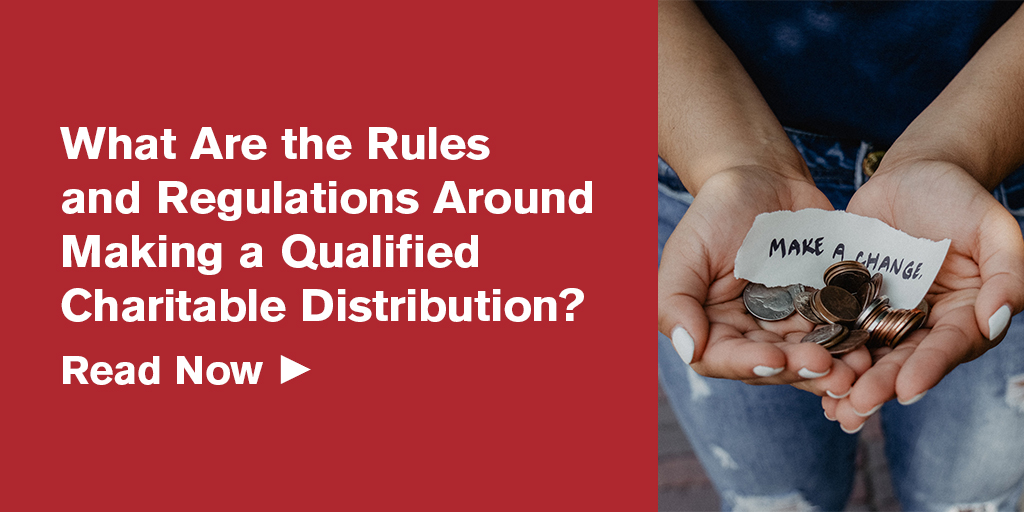Owners of Individual Retirement Accounts (IRAs) may be able to support their charities more tax-efficiently by donating directly from their IRA to the charity. IRA owners who are over age 70 ½ are eligible to distribute up to $100,000 per year to charities by making a qualified charitable distribution (QCD). The QCD is not included in taxable income of the account owner and the amount paid directly to the eligible charity cannot be claimed as a charitable contribution deduction. Any amount paid directly to a charity as a QCD counts against the IRA owner’s required minimum distribution (RMD) for the year. This is generally more tax efficient than receiving a taxable IRA distribution and making cash contributions to charities.
Under the 2017 federal tax reform, with the limitations on itemized deductions (e.g., $10,000 cap on state and local taxes and the elimination of miscellaneous itemized deduction) and the increased standard deduction, we have observed that many taxpayers are not receiving full benefit for their charitable contributions. For 2019 the standard deduction for a married couple filing jointly is $24,400 ($12,200 for single filers). So, for example, if a married couple does not have a mortgage, their only itemized deductions may be state and local taxes and charitable contributions. Under this scenario, the couple receives no tax benefit for the first $14,400 of their charitable contributions because the total itemized deduction does not exceed the standard deduction (assuming a $10,000 deduction for state and local taxes).
Some Rules and Regulations
- The account owner must be 70 ½ or older at the time the QCD is requested.
- The IRA owner may make up to $100,000 of QCD distributions during the calendar year. For a married couple filing jointly, provided each IRA account owner is at least 70 ½, each individual may make up to $100,000 of QCDs during the year from their IRA.
- The QCD must be paid directly from the IRA custodian to the eligible charity. This is accomplished by requesting that the IRA custodian issue a check from your IRA payable to the charity. You can then request that the check be mailed to the charity (recommended), or you may forward the check to the charity yourself. If the IRA distribution is made payable to the account owner, the distribution is taxable to the owner and it will not qualify as a QCD.
- QCDs can be made from traditional IRAs, inherited IRAs, SEP IRAs (inactive plans only) and SIMPLE IRAs (Inactive plans only). QCD cannot be made from any other qualified retirement plans including 401(k) and 403(b) plans.
- Certain charities are not eligible to receive QCDs, including donor advised funds, private foundations, and supporting foundations.
- The IRA owner making the QCD cannot receive any benefit in return for the QCD to the charity. For example, if the IRA owner’s donation covers the cost of a fundraising dinner event, the gift would not qualify as a QCD.
- The IRA custodian will report the QCD as a normal distributions on Form 1099-R. You will need to maintain records of the QCD, including the required charitable contribution acknowledgement letter for contributions over $250, so that the QCD is treated properly on your individual income tax returns.
There are a number of tax-efficient ways to support charities. The QCD is one that should be considered by individuals over 70 ½. Please contact your BPM tax advisor for questions regarding whether this might be appropriate for you.
Update: Under the federal “tax extenders” bill that passed in late December 2019, beginning in 2020, if individuals over age 70 ½ make IRA contributions, there can be limits on the QCD tax benefits. This new provision and other items contained in the recently passed legislation will be addressed in a separate posting.
 Owners of Individual Retirement Accounts (IRAs) may be able to support their charities more tax-efficiently by donating directly from their IRA to the charity. IRA owners who are over age 70 ½ are eligible to distribute up to $100,000 per year to charities by making a qualified charitable distribution (QCD). The QCD is not included in taxable income of the account owner and the amount paid directly to the eligible charity cannot be claimed as a charitable contribution deduction. Any amount paid directly to a charity as a QCD counts against the IRA owner’s required minimum distribution (RMD) for the year. This is generally more tax efficient than receiving a taxable IRA distribution and making cash contributions to charities.
Owners of Individual Retirement Accounts (IRAs) may be able to support their charities more tax-efficiently by donating directly from their IRA to the charity. IRA owners who are over age 70 ½ are eligible to distribute up to $100,000 per year to charities by making a qualified charitable distribution (QCD). The QCD is not included in taxable income of the account owner and the amount paid directly to the eligible charity cannot be claimed as a charitable contribution deduction. Any amount paid directly to a charity as a QCD counts against the IRA owner’s required minimum distribution (RMD) for the year. This is generally more tax efficient than receiving a taxable IRA distribution and making cash contributions to charities.
